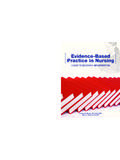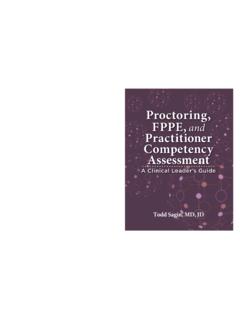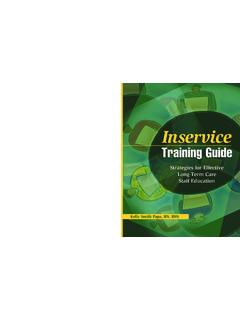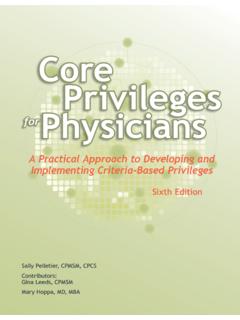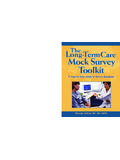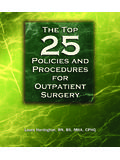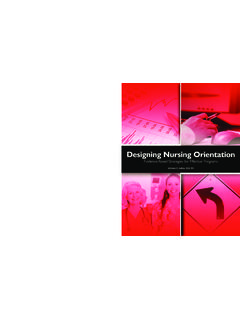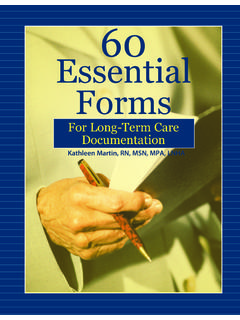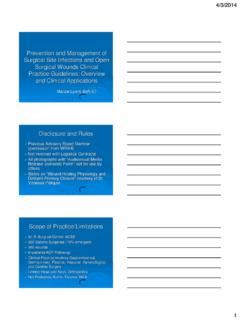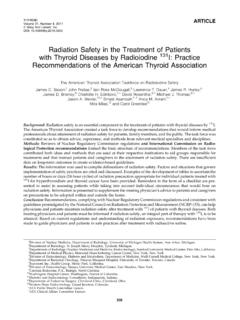Transcription of Evidence-Based v Practice in Nursing Evidence-Based A ...
1 Suzanne C. Beyea, RN, PhD, FAANMary Jo Slattery, RN, MSA guide TO SUCCESSFUL IMPLEMENTATIONE vidence-BasedPractice in NursingEvidence-BasedPractice in NursingA guide TO SUCCESSFUL IMPLEMENTATIONS uzanne C. Beyea, RN, PhD, FAANMary Jo Slattery, RN, MSEvidence- based Practice in Nursing : A guide TO SUCCESSFUL IMPLEMENTATION Beyea Slattery HCPROWant to implement Evidence-Based Practice , but don t know where to start? Evidence-Based Practice in Nursing : A guide to Successful Implementation defines Evidence-Based Practice and explains how to undertake your own projects. The book provides tips, tools, and resources to allow even novice RNs to Practice with of Interest .. Evidence-Based Advance Directives: A Study guide for NursesEvidence- based Pressure Ulcer Prevention: A Study guide for NursesEvidence- based Falls Prevention: A Study guide for NursesAbout HCProHCPro, Inc., is the premier publisher of information and training resources for the healthcare community.
2 Our line of products includes newsletters, books, audioconferences, training handbooks, videos, online learning courses, and professional consulting seminars for special-ists in health information management, compliance, accreditation, quality and patient safety, Nursing , pharmaceuticals, medical staff, credentialing, long-term care, physician Practice , infection control, and safety. Visit the Healthcare Marketplace at for information on any of our products, or to sign up for one or more of our free online e-zines. Box 1168 | Marblehead, MA Practice in Nursing : A guide to Successful Implementationiii 2006 HCPro, ..vAbout the authors ..viiChapter 1: What is Evidence-Based Practice ? ..1 Evidence-Based Practice ..1 Definitions of research utilization, quality improvement, and Nursing research ..2 EBP implications for nurses ..8 Chapter 2: Integration of Evidence-Based Practice ..15 First steps to Evidence-Based Practice ..15 Creating a culture of Evidence-Based Practice .
3 16 Creating a forum for discussion ..18 Identifying areas of concern ..20 Creating internal expertise ..21 Putting research into action ..24 Share the knowledge ..25 Chapter 3: Accessing and appraising resources ..29 Resources are widely available ..29 Searching for evidence ..30 Electronic indexes ..31 Electronic resources ..32 Levels of evidence ..41 Chapter 4: Evidence-Based Practice becomes a reality ..47 Questions for nurses ..47 Assess the organization ..48 Create a Nursing research council or Evidence-Based Practice council ..50 Models of Evidence-Based Nursing Practice ..56 Research champions ..58 Education on Evidence-Based Practice ..59 ContentsEvidence- based Practice in Nursing : A guide to Successful Implementationiv 2006 HCPro, of Evidence-Based Practice efforts ..60 Supporting inquiry ..61 Chapter 5: Journal clubs ..65 What are journal clubs? ..65 Guidelines for journal clubs ..66 Alternative approaches to traditional journal clubs.
4 67 Learning how to critique the Nursing literature ..68 Guidelines for the critique of Nursing research studies ..68 Chapter 6: Answering questions with Nursing research ..73 Overview of research methods ..73 Ask a research question ..74 Develop a research proposal ..76 Have the proposal reviewed ..77 Collaborating with external researchers ..82 Involve staff nurses in data collection or data analysis ..83 Dissemination: Publications and presentations ..83 Creating a research fellowship ..84 Questions that should not be answered by research ..85 Chapter 7: Nursing excellence and Evidence-Based Practice ..89 Relationship of Nursing excellence to Evidence-Based Practice ..89 Making EBP visible ..91 ANCC Magnet Recognition Program and Nursing excellence ..93 Providing evidence for designation ..95 Chapter 8: Examples of Evidence-Based Nursing Practice ..101 Engaging the Nursing staff ..101 Tailor EBP projects to organizational or departmental efforts.
5 104 Examples of Evidence-Based projects ..106 Nursing education instructional guide ..113 Evidence-Based Practice in Nursing : A guide to Successful Implementation1 2006 HCPro, is Evidence-Based Practice ?Learning objectivesAfter reading this chapter, the participant should be able to define Evidence-Based Practice (EBP) differentiate between Evidence-Based Practice , research, research utilization, and quality improvement describe the importance of EBP to Nursing Practice and high-quality patient careEvidence- based Practice During the 1980s, the term Evidence-Based medicine emerged to describe the approach that usedscientific evidence to determine the best Practice . Later, the term shifted to become evidence -basedpractice as clinicians other than physicians recognized the importance of scientific evidence in clinicaldecision-making. Various definitions of Evidence-Based Practice (EBP) have emerged in the literature,but the most commonly used definition is, the conscientious, explicit, and judicious use of the cur-rent best evidence in making decisions about the care of individual patients (Sackett, Rosenberg,Gray, Hayes, & Richardson, 1996).
6 Subsequently, experts began to talk about Evidence-Based healthcare as a process by which researchevidence is used in making decisions about a specific population or group of patients. evidence -basedpractice and Evidence-Based healthcare assume that evidence is used in the context of a particularpatient s preferences and desires, the clinical situation, and the expertise of the clinician. They alsoexpect that healthcare professionals can read, critique, and synthesize research findings and interpretexisting Evidence-Based clinical Practice OneEvidence- based Practice in Nursing : A guide to Successful Implementation2 Nurses ask numerous questions when looking to integrate Evidence-Based Practice into their clinical environment: What exactly is EBP? Is EBP the same as Nursing research? What is the difference between EBP and quality improvement? Is EBP relevant to Nursing Practice ? This book examines EBP and demonstrates its relevance to professional Nursing Practice and high-quality patient of research utilization, quality improvement, and Nursing researchEvidence- based Practice is not research utilization, quality improvement, or Nursing research,although it may be related to each of these processes.
7 For example, quality improvement projectsmay be Evidence-Based , and the findings may contribute to other EBP or research initiatives. Also,an Evidence-Based Practice project can lead to a research study or quality improvement is research utilization? For decades, nurses have used available research to guide Nursing Practice and their efforts toimprove patient outcomes. This process involved critical analysis and evaluation of research findingsand then determining how they fit into clinical Practice . Incorporating pertinent research findingsinto clinical Practice (and evaluating the changes effectiveness), helps close the gap between researchand recently, research utilization efforts in Nursing have been replaced by Evidence-Based Practice ,which will be described in further detail later in this is quality or performance improvement?Quality, clinical, or performance improvement focuses on systems, processes, and functional,clinical, satisfaction, and cost outcomes.
8 Typically, quality improvement efforts are not designed to develop Nursing Practice standards or Nursing science, but they may contribute to understanding best practices or the processes of care in which nurses are actively involved. 2006 HCPro, is Evidence-Based Practice ? Evidence-Based Practice in Nursing : A guide to Successful Implementation3 2006 HCPro, commonly accepted view is that quality improvement activities in healthcare are not intended togenerate scientific knowledge but rather to serve as management tools to improve the processes andoutcomes within a specific healthcare organization or setting. More recently, experts have focused onimproving care by examining and working within clinical microsystems or the specific places wherepatients, families, and care teams meet (Nelson, et al., 2002). To improve and maintain quality, safe-ty, and efficiency, clinical teams must blend analysis, change, and measurement into their efforts toredesign care within these clinical improvement initiatives generally address clinical problems or issues, examine clinicalprocesses, and use specific indicators to help evaluate clinical performance.
9 Data are collected andanalyzed to help understand both the process and the related outcomes. The findings help contributeto efforts to achieve and maintain continuous improvement through ongoing monitoring andimprovement example, a hospital might be interested in improving its smoking cessation education for hospi-talized patients, so it may convene a multidisciplinary team to address the issue. The team maydecide to measure the hospital s performance using the percentage of discharge summaries that indi-cate that a smoker received instruction about smoking cessation. The team might implement an edu-cational program and an electronic discharge summary that prompts clinicians to indicate whetherthe patient is a smoker and, if so, whether he or she received smoking cessation advice. They wouldmonitor the rate of compliance and modify the interventions until compliance with the requirementto provide smoking cessation advice is greater than 95%.Quality improvement projects vs.
10 Research projectsMany have asked whether quality improvement projects are the same as research projects they arenot. In clinical Practice , these efforts may seem similar in that, for example, both may seek answersto clinical problems and use similar data collection and analysis methods. However, factors that maydiffer include participant or subject recruitment, the study s methods, and how the results are example, in most quality improvement activities, the participants generally are the patients with-in a specific clinical microsystem. In research efforts, the investigator recruits human subjects usingapproaches that will ensure a representative sample of the population. In many improvement activi-ties, the intervention may change as it is evaluated, whereas in a research study the treatment orintervention remains the , in most quality improvement initiatives, the healthcare team is trying to solve a prob-lem in a particular setting instead of trying to generalize the results of the study to other settings and populations.
